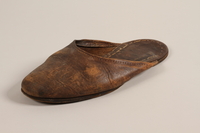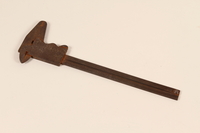Overview
- Description
- Contains restitution papers for Samuel Klasner's experiences as a slave laborer during the Holocaust.
- Credit Line
- United States Holocaust Memorial Museum Collection, Gift of Bruce Klasner
Physical Details
- Genre/Form
- Letters.
- Extent
-
1 folder
Rights & Restrictions
- Conditions on Access
- There are no known restrictions on access to this material.
- Conditions on Use
- Material(s) in this collection may be protected by copyright and/or related rights. You do not require further permission from the Museum to use this material. The user is solely responsible for making a determination as to if and how the material may be used.
Keywords & Subjects
- Topical Term
- Restitution and indemnification claims (1933-)
Administrative Notes
- Holder of Originals
-
United States Holocaust Memorial Museum
- Legal Status
- Permanent Collection
- Provenance
- The papers were donated to the United States Holocaust Memorial Museum in 2017 by Bruce Klasner, the son of Samuel Klasner.
- Record last modified:
- 2023-04-12 08:53:29
- This page:
- https://collections.ushmm.org/search/catalog/irn592471
Download & Licensing
- In Copyright - Use Permitted
- Terms of Use
- This record is not digitized and cannot be downloaded online.
In-Person Research
- Request 7 Days in Advance of Visit
- Plan a Research Visit
-
Request in Shapell Center Reading Room
Bowie, MD
Contact Us
Also in Sam Klasner collection
The collection consists of a pair of shoes, calipers, a certificate, documents and photographs relating to the experiences of Sam Klasner during the Holocaust when he was a forced laborer in the factory owned by Oskar Schindler in German occupied Czechoslovakia and after the Holocaust when he lived in a displaced persons camp in Germany. Some of these materials may be combined into a single collection in the future.
Date: 1945-1949

Pair of leather slippers received from Oskar Schindler by a Jewish Polish worker
Object
Pair of leather slipon shoes given to Sam Klasner by Oskar Schindler from a store of Red Cross supplies shortly before liberation. From October 1944-May 1945, Sam worked at the armament factory owned by Schindler in Brunnlitz (Brnenec) in German occupied Czechoslovakia as a subcamp of Gross Rosen concentration camp. Schindler protected his workers from deportation, kept German camp personnel out of the camp, and did his best to provide food, although shortages were severe. In October 1944, when Schindler moved his factory from Płaszów to Brunnlitz, his workers were processed at Gross Rosen. Some were mistakenly sent to Auschwitz and had to be replaced. Sam had mechanical skills and was offered a spot on Schindler's list and sent to Brunnlitz. Sam was first imprisoned by the Germans in 1939 as a Polish soldier captured after the German invasion of Poland. When they realized he was Jewish, he was incarcerated in the Krakow ghetto. In June 1941, he was sent to Reichshof [Rzeszow] forced labor camp, then in September 1942, transferred to the brutal Płaszów labor camp until his transfer to Gross Rosen in 1944. Schindler left the Brunnlitz camp on May 7, 1945, the day Germany surrendered. The camp was liberated May 9 by Soviet troops. Sam was sent to Poland to search for his family but found no survivors. He was nearly killed in a pogrom and left for the American zone of occupation in Germany. He learned that his family had been killed in Treblinka and Auschwitz. Sam stayed in Regensburg displaced persons camp and emigrated to the United States in 1949.

Vernier calipers used by a Jewish Polish worker in Oskar Schindler's armament factory
Object
Vernier calipers, a measuring tool, used by Sam Klasner in Oskar Schindler's armament factory in Brünnlitz (Brnenec), in German occupied Czechoslovakia from October 1944-May 1945. The factory was a subcamp of Gross Rosen concentration camp. Schindler protected his workers from deportation, kept German camp personnel out of the camp, and did his best to provide food, although shortages were severe. In October 1944, when Schindler moved his factory from Płaszów to Brunnlitz, his workers were processed at Gross Rosen. Some were mistakenly sent to Auschwitz and had to be replaced. Sam had mechanical skills and was offered a spot on Schindler's list and sent to Brunnlitz. Sam was first imprisoned by the Germans in 1939 as a Polish soldier captured after the German invasion of Poland. When they realized he was Jewish, he was incarcerated in the Krakow ghetto. In June 1941, he was sent to Reichshof [Rzeszow] forced labor camp. In September 1942, he was transferred to the brutal Płaszów labor camp until his transfer to Gross Rosen in 1944. Schindler left the Brunnlitz camp on May 7, 1945, the day Germany surrendered. The camp was liberated May 9 by Soviet troops. Sam was sent to Poland to search for his family but found no survivors. He was nearly killed in a pogrom and left for the American zone of occupation in Germany. He learned that his family had been killed in Treblinka and Auschwitz. Sam stayed in Regensburg displaced persons camp and emigrated to the United States in 1949.
Sam Klasner papers
Document
The papers consist of an identification document and thirty photographs. The identification document was issued to Samuel Klasner [donor's father] and states that he is a former prisoner of the concentration camp Gross Rosen; it is printed on stationery for the "Deutsche Emailwar..fabrik" factory of Oskar Schindler. The thirty vintage copy prints with a variety of propaganda and post-liberation photographs were acquired by Samuel Klasner while living in Regensburg, Germany. Also includes restitution papers for Samuel Klasner's experiences as a forced laborer during the Holocaust.



